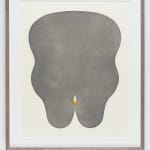Alice Tippit
Further images
Alice Tippit’s Flute, 2024, is an Intaglio and monoprint in an edition of 12 and printed from a copper plate. While the artist works most often in the form of painting, mixed media on paper, and sculpture, Flute carries into print Tippit’s deeply observant and quietly literary sensibility. In 2016, critic Johanna Fateman described Tippit’s compositions as “unsolvable riddles” with a “cool, formal harmony.”
Tippit offers cues of information, and in works on paper the unworked material itself can have formal significance. Here it serves as both candle and wick, containing the darkness illuminated by the flame; yet the undulating form (in gray ink) surrounding the flame can also be read as a figure, deepening the potential readings for the image. The corporal shape, as with the flame motif, is recurrent in Tippit’s work– to which we might reference her earlier painting, Part; or Shriek, a work on paper. Each with its own narrative potential, they embody a radical strangeness that runs current-like through Tippit’s practice.
The candle is symbolic of an individual life, particularly as a reminder of its brevity; its illumination aligned with the pursuit of knowledge. The perceptual trick of the figure-ground relationship in Flute complicates those familiar associations. The image contains the darkness illuminated by the flame but also gives it form, allowing for reflection on the limits of our awareness as well as that which ignites our imagination: a small fire helps us to carry on even as we know that our time is all too brief. Accordingly, for each print in this edition, the flame’s yellow and orange ink is hand applied and unique, giving form to a fire’s flickering quality.







